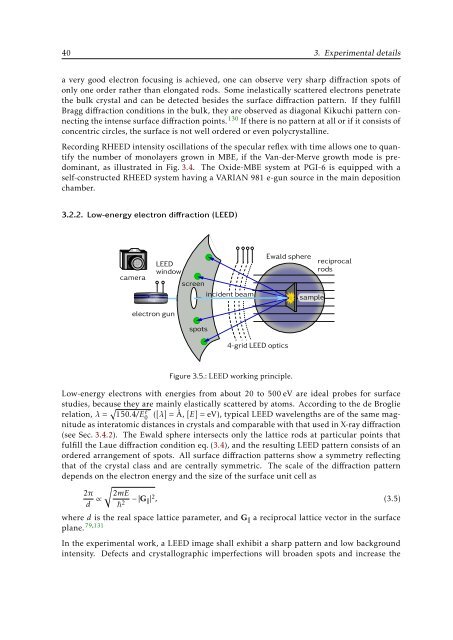Text anzeigen (PDF) - Universität Duisburg-Essen
Text anzeigen (PDF) - Universität Duisburg-Essen
Text anzeigen (PDF) - Universität Duisburg-Essen
You also want an ePaper? Increase the reach of your titles
YUMPU automatically turns print PDFs into web optimized ePapers that Google loves.
40 3. Experimental details<br />
a very good electron focusing is achieved, one can observe very sharp diffraction spots of<br />
only one order rather than elongated rods. Some inelastically scattered electrons penetrate<br />
the bulk crystal and can be detected besides the surface diffraction pattern. If they fulfill<br />
Bragg diffraction conditions in the bulk, they are observed as diagonal Kikuchi pattern connecting<br />
the intense surface diffraction points. 130 If there is no pattern at all or if it consists of<br />
concentric circles, the surface is not well ordered or even polycrystalline.<br />
Recording RHEED intensity oscillations of the specular reflex with time allows one to quantify<br />
the number of monolayers grown in MBE, if the Van-der-Merve growth mode is predominant,<br />
as illustrated in Fig. 3.4. The Oxide-MBE system at PGI-6 is equipped with a<br />
self-constructed RHEED system having a VARIAN 981 e-gun source in the main deposition<br />
chamber.<br />
3.2.2. Low-energy electron diffraction (LEED)<br />
camera<br />
LEED<br />
window<br />
screen<br />
incident beam<br />
Ewald sphere<br />
sample<br />
reciprocal<br />
rods<br />
electron gun<br />
spots<br />
4-grid LEED optics<br />
Figure 3.5.: LEED working principle.<br />
Low-energy electrons with energies from about 20 to 500 eV are ideal probes for surface<br />
studies, because they are mainly elastically scattered by atoms. According to the de Broglie<br />
relation, λ = √ 150.4/E0 e− ([λ] = Å, [E] = eV), typical LEED wavelengths are of the same magnitude<br />
as interatomic distances in crystals and comparable with that used in X-ray diffraction<br />
(see Sec. 3.4.2). The Ewald sphere intersects only the lattice rods at particular points that<br />
fulfill the Laue diffraction condition eq. (3.4), and the resulting LEED pattern consists of an<br />
ordered arrangement of spots. All surface diffraction patterns show a symmetry reflecting<br />
that of the crystal class and are centrally symmetric. The scale of the diffraction pattern<br />
depends on the electron energy and the size of the surface unit cell as<br />
2π<br />
d ∝ √<br />
2mE<br />
2 − |G ‖ | 2 , (3.5)<br />
where d is the real space lattice parameter, and G ‖ a reciprocal lattice vector in the surface<br />
plane. 79,131<br />
In the experimental work, a LEED image shall exhibit a sharp pattern and low background<br />
intensity. Defects and crystallographic imperfections will broaden spots and increase the
















